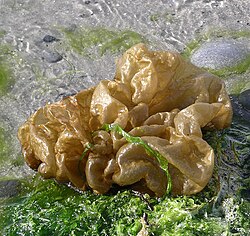| Leathesia | |
|---|---|
 | |
| Leathesia difformis | |
| Scientific classification | |
| Domain: | Eukaryota |
| Clade: | Sar |
| Clade: | Stramenopiles |
| Phylum: | Ochrophyta |
| Class: | Phaeophyceae |
| Order: | Ectocarpales |
| Family: | Chordariaceae |
| Genus: | Leathesia S.F.Gray, 1821 |
Leathesia is a genus of brown algae belonging to the family Chordariaceae. [1]
The genus has cosmopolitan distribution. [1]
Species: [1]
- Leathesia berkeleyi (Greville) Harvey
- Leathesia difformis L.
- Leathesia marina (Lyngb.) Decne.
- Leathesia mucosa Feldmann, 1935
- Leathesia nana S. & G.
- Leathesia umbellata (C.Agardh) Endlichter